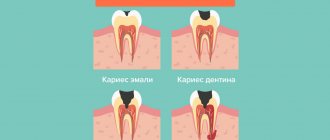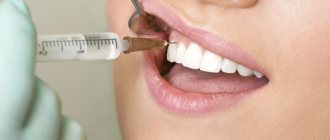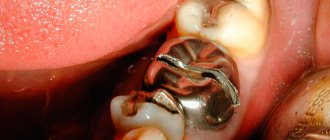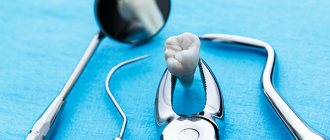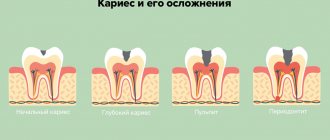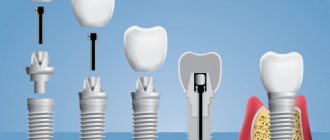Causes Possible complications What to do about pain?
How to relieve pain? Prevention The vitality of a tooth, in particular its sensitivity, is ensured by the neurovascular bundle (pulp). Removal of the pulp (depulpation) is a forced measure, which is resorted to for serious indications (pulpitis, hilar cyst, damage to the pulp chamber due to trauma, etc.). Painful discomfort for several days after depulpation is a normal tissue reaction to the intervention. But if a tooth hurts after removing the nerve and filling the canals 2-3 weeks later
or pain occurs suddenly long after endodontic treatment, this is a good reason to see a dentist.
Even treated teeth should be examined every year to diagnose or rule out complications at an early stage. A pulpless tooth does not hurt, but it is like a time bomb. Poor-quality canal treatment can provoke complications that destroy the jaw bone and cause purulent processes (cysts, abscesses) that are life-threatening. Properly treated canals are the foundation of any restoration. The more modern and high-quality the materials used for their processing, the less likely there are complications.
Can a tooth hurt after nerve removal?
A tooth from which the nerve has been removed is called “dead.” According to logic, a tooth without a nerve cannot hurt. But tissues need time to recover after endodontic treatment. Therefore, reactive pain after dental treatment can normally persist for several days. Over time, it weakens and goes away on its own. Painful sensations usually occur when pressure is applied or while eating - they can last 1-3 days
,
a week maximum
.
The picture is completely different when the pain increases, becomes throbbing, the gums are swollen, red, swollen, and symptoms of intoxication appear - headache, fever, weakness. Such symptoms indicate the development of complications and require immediate attention to the dentist. The doctor will determine why the dead tooth hurts and provide effective treatment.
How to survive nerve removal - step-by-step instructions
Here is a short step-by-step instruction on how to prepare for dental nerve removal and what to do after the operation.
Step one. First, find out why it is necessary to remove the nerve. Decaying nerve tissue allows bacteria to multiply. This is fraught not only with infection, but also with swelling that can spread to the neck, face, loss of bone around the tip of the root, and drainage problems beyond the latter.
Find out the reason for dental pulp removal
Step two. Find out if this procedure is really necessary. The fact is that in some cases not all symptoms of the problem appear.
Determine if you need to undergo a nerve removal procedure
Step three. Visit your dentist. Removing a dental nerve requires one or even several trips to the dental clinic.
Go to the dentist
Step four. Familiarize yourself with the depulpation process, which includes:
- X-ray;
- local anesthesia;
- placing a rubber plate in the mouth to control salivation;
- drilling a hole to access the dental nerve;
- root canal cleaning;
- filling;
- restoration (for protection, for example, a crown can be installed).
Familiarize yourself with the nerve removal or depulpation procedure
Step five. Study the consequences of the procedure. The tooth may hurt for two or three days, but you should not chew hard food on the affected side. To reduce discomfort, you can use over-the-counter pain relievers.
- Frequent urination or why do I pee so often?
Learn about the consequences of nerve removal
If you have questions or comments, write. Also, do not forget to subscribe to site news. I wish you to solve all your dental problems as quickly as possible and not think about them again.
Reasons why a tooth without a nerve hurts
- Re-infection
- not all affected tissues were removed, the source of infection remained, and the inflammation began to spread again. This can happen if endodontic treatment is performed without a dental microscope or if the dental canals have a very complex structure, which does not allow for high-quality cleaning and disinfection. - Poor-quality filling
- when filling the canal, there are voids left in the canal, areas not filled with material, in which pathogenic microorganisms begin to multiply, which leads to inflammation, the development of periodontitis, the formation of cysts, granulomas. - The exit of the filling masses
beyond the root apex - the filling material, having exited through the apical foramen, hardens in the periodontal tissues, compresses the nerve endings, and disrupts blood circulation. Inflammation develops in the periodontium, accompanied by severe pain. - Perforation of the canal walls
– in the area of perforation, the dental tissue becomes infected and inflamed; during filling, the composite may escape beyond the boundaries of the canal. - Incomplete depulpation - due to the complex structure of the canals, the doctor was unable to remove one of the nerve endings. The use of a dental microscope with good optics significantly improves access to the prepared cavity and facilitates the detection of the canal orifices and all nerve branches.
- A fragment of an instrument
in the canal - during expansion, cleaning, filling, a piece of the instrument could break off and remain in the dental canal. The presence of a foreign object contributes to the formation of voids, where conditions are created for the proliferation of bacteria and the development of inflammation. - An allergy
to filling materials or a drug is accompanied by pain, swelling, and discomfort in the area of the dental unit. - A filling that is too high
– the opposite tooth (antagonist) puts excessive pressure on the filling, which leads to the appearance of pain. - Damage to the adjacent unit
- pain spreads (radiates) along the gum from the adjacent tooth.
Possible reasons
Statistics confirm that in most cases when toothache persists after nerve removal, the phenomenon is caused by poor quality work done by the dentist. You should always remember that choosing a clinic and specialist must be approached responsibly, because the goal of saving on work and materials is not always justified. For the most part, it is simply impossible to prove a medical error later; the dentist is in no hurry to admit his mistake and correct it.
After removal of a nerve, it is not always the doctor’s fault that the tooth hurts when pressed; in some cases, the molar may ache due to an allergy to the material of the filling that was installed during the treatment. Next we will talk about the most common problems that lead to the fact that the nerve has been removed and the tooth hurts, and quite intensely.
Injury to root tip tissues
Often, a tooth can react strongly to nerve removal, with some nuances made during the procedure:
- during the removal of the nerve, a part of the nervous tissue, along with blood vessels, was torn off in the area of the apex of the molar root;
- during the processing of roots with instruments, the tissues were injured by the tip of the metal, especially if they went beyond the edge of the root;
- during treatment with strong antiseptics, some of the liquid got beyond the root tip, causing inflammation and subsequent pain there.
If the tooth hurts when pressed for no longer than 3-4 days in a row, it means that the filling was carried out efficiently, but the canal treatment itself and the nerve removal procedure were not.
Poor quality of root canal filling
How much the tooth hurts after removal of the nerve and subsequent filling depends on how well the canals were sealed. If a patient’s gums are swollen, it hurts to press on a molar from above, or to bite off food; such symptoms indicate that the dentist’s work was not done very well. If a tooth hurts sharply and severely, this is good, because severe discomfort will force a person to immediately visit the doctor again, without waiting for complications.
Pain that can be tolerated is sometimes endured by patients for months without finding out its cause. Nerve inflammation is a process caused by pathogenic bacteria entering the incisor cavity. During treatment, the dentist expands the tooth canals, cleans them, treats them with antiseptics, removes the nerve, but still a small amount of pathogenic flora remains inside the tooth.
If the root canals were not completely filled with filling material, then voids form in the cavity of the dental tissue, the molar becomes inflamed, causing severe discomfort to the person. Such pain cannot be tolerated - a number of molars are connected to each other by nerve trunks and blood vessels, so infection through the capillaries can easily spread to the adjacent tooth, causing destruction of its root, and this is fraught with the formation of a periodontal abscess.
What should you do if it is painful to touch a tooth after nerve removal and filling, and the discomfort is intense? Immediately go to the dentist again, he must open the canal and fill it again. If the voids inside the root (which are visible on an x-ray) are located only at the apex, resection is performed; in this case, it is not necessary to completely open the molar.
The x-ray image shows a section of the canal where a void remains, without filling
Extraction of material beyond the apex of the root canal
Treatment of gums after tooth extraction
After the nerve is removed, the process of filling the root canals with the selected material begins. If some of it accidentally falls outside the apex, the person may experience severe pain. You should not wait longer than 3 days; it is better to contact the dentist immediately if the discomfort does not subside. This advice applies to the intense pain that occurs when a large amount of material is removed from the root.
If the amount is minimal, the pain may go away on its own in a month or two, the main thing is that the patient can sleep, eat and work peacefully. A large amount of material is removed through a hole in the bone tissue, which is made during surgery. The manipulation is not considered difficult, it takes 30-40 minutes.
Remnant of a metal instrument in the root canal
When removing a nerve, the doctor must clean the canals using dental instruments. During the inept work of the doctor, a fragment of the instrument may remain in one of the parts of the canal, well, if in the first third, then it can be easily removed.
If a piece is stuck under the filling at the very base of the root, it will not be so easy to pull it out. The dentist is required to take an x-ray to confirm his mistake, reopen the canals and remove part of the instrument. Otherwise, the tooth cannot be fully filled, and inside the voids the active proliferation of bacteria will begin, destroying the molar.
Allergic reaction
Everyone has heard about modern fillings - they are made from high-quality materials, their installation is simple and painless, and the adaptation process is short. Even if the nerve was removed, installing a filling will not cause any pain to the patient. However, no one has canceled the banal allergic reaction to filling material; it is accompanied by the following symptoms:
- swelling of the gums;
- redness of the oral mucosa;
- itching and burning in the area of the treated tooth;
- aching pain.
People predisposed to allergies should choose a filling carefully, consulting with a doctor
Elimination of such symptoms is achieved by replacing the filling material with another that does not cause such a reaction. The patient should always warn the dentist if he has a tendency to any kind of allergy in order to avoid problems.
Possible complications
- Periodontitis;
- formation of granuloma, hilar cyst;
- periostitis (flux);
- complete destruction and/or loss of the tooth;
- osteomyelitis.
To exclude complications associated with poor-quality endodontic treatment, control radiography is performed at the RUTT clinic in Moscow, and an apex locator is used to assess the depth of the canals. The use of computed tomography and an operating microscope provide more opportunities for accurate diagnosis and quality treatment.
How does the procedure work?
The time has long passed when the dentist had to perform treatment almost blindly. Now all modern clinics have portable X-rays, many have a computed tomography machine, and the doctor can get a complete picture of the condition of the patient’s oral cavity in a matter of minutes.
To avoid serious complications, the most common of which is tooth pain after nerve removal, an X-ray or tomogram (panoramic or of a strictly defined area) must be taken before depulping. Only in this way can the dentist assess:
- severity of the pathological process;
- length and shape of the dental canal;
- changes in the structure of the periodontium (connective tissue surrounding the roots);
- condition of neighboring dental units: with lateral caries, sometimes when one tooth is depulped, it is easier to immediately fill the neighboring ones.
Basic techniques
Currently, doctors use one of the following methods of therapy:
- Vital. Most often used. All manipulations are carried out during one patient visit: using special devices, the dentist completely cleans the canals, after which the cavity is sealed. More often they put a permanent filling, sometimes (usually when treating chronic, advanced inflammation) a temporary filling, which after 3-5 days, if there is no pain in the tooth after removing the nerve, it is replaced with a regular one.
- Devital. A special paste is first placed into the canals, which causes necrosis of the pulp tissue. In addition to the devitalizing component, such medications also contain antiseptics, so the drug additionally has a disinfecting effect. Previously, pastes containing arsenic were used for this purpose; now modern, completely safe medicines are used. The prepared cavity is sealed with temporary filling material for several days. During the second visit, the devitalized tissue is removed, the canals are filled and the crown is restored with photopolymer materials.
What to do if a pulpless tooth hurts?
Soreness after depulpation is a normal tissue response to the intervention. But such symptoms should subside within a couple of days after endodontic treatment. If the canal of a tooth without a nerve hurts and the pain does not subside, but rather increases, you need to consult a dentist. The pain can be different - pressing, aching, throbbing, radiating to the eye socket, temple, cheek. In addition to pain, redness and swelling may occur. An allergy to a material or an antiseptic drug is usually accompanied by a burning sensation, fever, general weakness, and a feeling that the tooth “rises” above neighboring units.
The deeper the pathological process goes, the more pronounced the symptoms. As soon as the inflammation spreads to the periodontium, a person begins to feel pain when biting or pressing on a tooth. When pus accumulates on the gum, a fistula is formed, through which the outflow of purulent contents is ensured, temporarily alleviating the condition. The presence of a fistula is a direct indicator that there is a problem with the roots of the tooth.
The doctor will conduct a diagnosis and determine the exact cause of the pain. To do this, an examination is carried out and a number of x-ray studies are performed:
- targeted photographs of the affected tooth in different projections;
- orthopantomogram;
- 3D tomography.
The doctor selects therapeutic tactics according to the clinical picture. If the pain occurs due to re-infection, an allergy to the material, or errors in the initial treatment, re-treatment is carried out - the root canals are opened, processed and filled. If the pain is caused by pulpitis or deep caries of an adjacent dental unit, treat it. Cysts, flux, osteomyelitis are treated surgically - the gums are cut, cleaned, and the affected areas are removed along with part of the tooth root (according to indications). If it is not practical to save a tooth, it is removed followed by prosthetics.
Why does a tooth hurt when pressed?
If the tooth does not bother you until you start chewing or pressing on it, most likely the reason lies in problems with the ligaments that “attach” the tooth to the jawbone, or due to slight swelling that will subside in a few days.
However, there are other reasons:
- A fragment of a dental needle remained in the canal.
- Excess filling material has gone beyond the root of the tooth and landed on the jaw bone.
- The nerve was not completely removed (in this case the tooth hurts even with light tapping).
- During the treatment of caries, an infection got into the root canals.
If you feel a sharp pain when pressing, it hurts to chew and even speak, you must urgently go to the clinic, take an x-ray and repeat the operation to clean and fill the canals, having previously eliminated possible foci of inflammation.
We correct other people's mistakes. Dental retreatment with a 10% discount
Moscow
How to relieve pain
If a tooth hurts severely after treatment of pulpitis, taking a pain reliever (Analgin, Ibuprofen, Ketolac, etc.), rinsing the mouth with an antiseptic solution or a warm herbal decoction of lemon balm, sage, oak bark, chamomile, will help temporarily relieve the pain symptom and alleviate the condition. calendula.
It is strictly forbidden to heat a sore tooth, apply alcohol or garlic compresses to the gums, or take antibiotics or aspirin.
Prevention
If for some reason you had to depulpate a tooth, you should not think that now it will never bother you again - without proper preventive measures, the likelihood of pain is very high. To avoid complications, follow simple rules:
- Do not eat or drink for 2 hours after surgery - this will reduce the risk of infection under the filling. Smoking and drinking alcohol are not recommended for at least 24 hours after treatment.
- Take anti-inflammatory pain medications as recommended by your dentist.
- At first, try to reduce the chewing load on the pulpless tooth.
- Regular hygiene. Immediately after treatment, buy a toothpaste to reduce tooth sensitivity. In the future, brush your teeth 2 times a day, do not neglect dental floss and mouth rinses.
- Professional hygiene. Visit your dentist at least once every six months. Make an appointment for a professional plaque and tartar cleaning once a year. To protect your teeth from adverse external influences, go through the procedure of fissure sealing, and to strengthen the enamel - remineralization or fluoridation.
And remember - everything in our body is interconnected. Don’t wait for pain – at the first signs of discomfort after dental treatment, contact your doctor immediately.
Author: Elena Kopylova Dentist-therapist, endodontist, pediatric dentist. Work experience more than 7 years. The information is for reference only. Before treatment, consultation with a doctor is necessary.
Prevention of complications
- Visit your dentist regularly for check-ups, contact your dentist immediately if your tooth hurts after root canal cleaning;
- consult a doctor immediately if there are signs of an allergy to the filling material, increased pain, fever, swelling of the gums or face;
- follow the doctor’s recommendations after endodontic treatment regarding oral care and medications;
- do not self-medicate.
Author of the article Voznyuk Vladimir Aleksandrovich Maxillofacial surgeon-implantologist of the highest category
Work experience: 28 years.
What complications may arise?
Pain is one of our body's defense mechanisms. If there is pain, it means one of the systems is not working correctly, and there is a certain pathology. If you do not pay attention to these signals for help in time, you may encounter serious complications:
- Inflammation under the tooth
. At first it will be concentrated in one place. But in the absence of proper treatment, it will spread to nearby tissues, and then, through the bloodstream, throughout the body. - Infection of adjacent teeth
. If the cause of the pain is the proliferation of pathogenic bacteria, it is likely that the infection will spread to the soft tissue of the gums and then spread throughout the entire oral cavity.
If, after removing a nerve, a wisdom tooth hurts, then, contrary to popular belief, it is not necessary to remove it - if it is possible to repeat the treatment, eliminating the source of infection and inflammation, the doctor will definitely do everything in his power to save the tooth.
In the most advanced cases, the doctor usually decides to remove the filled tooth.
What to do if a tooth hurts under a filling, in which there is no nerve, but sensitivity remains
With persistent pain and progressive sensations, the only right decision is to consult a doctor. Only he can remove the pulp completely, even if the nerve endings were left behind, and also determine an additional cause for the symptoms.
Emergency methods of control
If it is not possible to urgently go to the dentist, then it is quite possible to relieve the pain caused by the inflamed nerve residue. To do this, it is enough to drink a strong painkiller or use traditional methods - rinses, lotions. Note that medications need to be dosed, and their compatibility with other drugs must be monitored.
And most importantly, you need to understand that these are only temporary measures that are needed to hold out until the moment when a doctor sees you and provides assistance.
Using medications at home
Even after proper treatment in the dental office, pain is a normal reaction due to irritation of the gums, as well as aching enlarged canals and neighboring teeth. But no one wants to live with constant pain for 7-10 days, so immediately after leaving anesthesia it is recommended to take drugs such as Analgin, Ibuprofen; Ketorol and its analogues are considered the most effective. This will not only remove the symptoms, but also stop the inflammatory process and relieve swelling. You cannot take pills every day. Therefore, if symptoms increase, you should immediately make an appointment with a doctor.
Causes of pain
The occurrence of pain after tooth extraction is associated with damage to nerve endings, vascular structures and soft tissues. The peak intensity of pain occurs in the first hours after the cessation of anesthesia. The symptom persists for about 12 hours.
In case of incisions in the gums or damage to the bone tissue, as well as after implantation after removal, toothache may persist for 2-3 days. Pain syndrome also occurs in the case of displacement of the dentition towards the formed void. Therefore, doctors recommend prosthetics as soon as possible after extraction.
Pain during difficult removal
The duration of pain after complex extraction (wisdom teeth, impacted or dystopic incisors) is associated with damage to a larger tissue area. Often such an operation involves making an incision in the gum, sawing out the roots, extracting tooth fragments, and draining an abscess, which increases the scope of the surgical intervention. If your ear hurts after wisdom tooth removal, this may indicate nerve damage.
In some cases, patients complain of persistent discomfort and pain for up to a week. Clinical manifestations such as swelling, swelling of the gums, enlarged submandibular lymph nodes, fever, and malaise are also common.
When you can and when you can’t tolerate pain after filling
My tooth hurts under a filling, what should I do? First of all, do not panic, but calmly understand the situation. If a tooth hurts after a filling, the nature of the pain and the appearance of some other symptoms matter.
Tooth hurts under temporary filling
The intensity of pain under the temporary filling should gradually decrease
Can a tooth hurt under a temporary filling? Of course, it can, but natural pain is not severe, and its intensity gradually decreases. The tooth hurts after filling, mainly during the day, when it is subjected to one or another impact - pressure (chewing hard food), drinking hot, cold or sour drinks.
- Possible reasons : most often, this is normal, the tooth begins to hurt for natural reasons. Painful sensations can also occur due to overheating of tissues during preparation, light-curing of fillings, problems with drying the dental cavity after preparation, or fillings that are excessive in height.
- What is the best way to relieve pain : for natural pain and pain associated with minor violations of the therapeutic process, it is enough to rinse your mouth with an infusion of chamomile flowers and take an anesthetic (Analgin, Pentalgin, Nise).
Acute pain after filling
Very often, a tooth hurts after root canal cleaning and filling. The acute nature of the pain syndrome is associated with injury or inflammation of sensitive tissues - pulp or periodontium. Much also depends on the pain sensitivity of the patient himself.
- Possible reasons : incomplete removal of pulp from the tooth cavity.
- What is the best way to relieve pain : take a painkiller and see a dentist.
Read more about the causes and methods of eliminating acute pain in the teeth in this article.
Throbbing pain after filling
If the tooth hurts severely after filling, the pain has become throbbing, then this is a sign of inflammation of the pulp - pulpitis. A sharp headache often appears.
- Possible causes : the cause of pulsating pain syndrome may be poor-quality treatment of the dental cavity and root canals, possibly perforation of the walls.
- What is the best way to relieve pain : take any painkiller orally and immediately consult a dentist.
Only a dentist can relieve throbbing pain
Aching pain after filling
When a tooth aches after a filling is placed, this is normal. How long a tooth hurts after canal filling depends on the complexity of the manipulations performed. The intensity of the pain is important: if it increases, the pain intensifies sharply when pressed, then this is a symptom of incipient inflammation. A decrease in intensity is a favorable sign.
- Possible reasons : this is natural pain in a filled tooth.
- What is the best way to relieve pain : rinse with a decoction of oak bark or an infusion of chamomile flowers. If the pain seems too severe, take a pain reliever.
Read about how to eliminate aching toothache here.
Tooth hurts after filling when pressing
If a tooth hurts after a filling when you bite it, then most often it has natural causes and goes away in five to seven days.
- Possible reasons : if after filling a tooth hurts when pressed, then most often this is a consequence of treatment and injury to dental tissues.
- How best to relieve pain : temporarily avoid chewing food on the side of the filling, rinse your mouth with light antiseptics and herbal decoctions.
What can hurt after filling?
The pain associated with the installation of a filling directly depends on the structure of the tooth. It consists of a crown, neck and root. On top, all these structures are covered with hard dental tissues that do not have nerve endings. In the crown area it is dentin and enamel, in the root area it is cement. Inside, under the hard covering in the crown area, there is a dental cavity filled with pulp - a pulp that has many nerve endings and blood vessels. The cavity is connected to root canals, also filled with pulp. In the area of the apex (apex), the root is connected to the bone tissue of the jaw using a ligament - the periodontal ligament, which has excellent innervation.
Conclusion: a tooth can only hurt if the pulp and periodontium are diseased or injured during filling.
Canal cleaning and filling
The most common cause is caries - a pathological process accompanied by the destruction of hard dental tissues. This opens access to the dental cavity, root canals and periodontal tissue, inflammation or irritation of which causes severe pain.
Preparing a tooth for filling
Filling is a method of treating caries, but this process itself can cause mechanical irritation of soft tissues, accompanied by pain. Minor pain may be normal, but sometimes you cannot do without the help of a specialist.
In the superficial and middle stages of caries, the affected hard tissues are removed and a filling is placed on top, restoring the shape of the tooth. The dental cavity remains closed. This treatment is absolutely painless and does not require anesthesia. An even more effective way is to have your teeth professionally cleaned to remove plaque and tartar. Regular implementation of this procedure prevents the development of caries and allows you to keep all your teeth healthy for a long time.
Tooth preparation and depulpation
With deep caries, a hole forms in the hard tissues and an infection enters the dental cavity, causing intense pain. In such cases, before filling, preparation is carried out to remove damaged hard tissues and expand the cavity. If necessary, the old filling is also removed. Then the pulp is removed (depulping).
This is a painful procedure, but modern local anesthetics used in dentistry allow the patient to experience no pain at all. If deep caries has developed not so long ago, and the periodontal tissues are healthy, then it is possible to remove only the pulp from the dental cavity (amputation), after which a therapeutic lining is applied and a temporary filling is installed. If there is no pain, a permanent filling is placed after a few days.
In case of long-standing caries, the pulp is first completely removed from the dental cavity, and then from the root canals (extirpation). At the same time, the cost of filling increases.
It is very important to carefully remove the pulp (patients often call it the nerve) from the canal, making sure that no particles of destroyed hard tooth tissue remain in it. All this can support a long-term inflammatory process.
If a tooth hurts after canal filling, the infection can gradually reach the root apex, causing an inflammatory process in the periodontium, accompanied by fever and pain.
Treatment at home
Without the help of a specialist, symptomatic therapy can be carried out using pharmaceutical medications and traditional methods of therapy.
Important to remember! Home treatment can only relieve pain when pressed for a short period of time. To completely get rid of a symptom, you need to eliminate the cause of its occurrence.
Medicines
When treating toothache after depulpation, the following drugs are used:
- You need to take medications in accordance with the dosages indicated in the instructions, unless there are contraindications.
Ketanov;
- Paracetamol;
- Analgin;
- Ibuprofen;
- Spasmalgon;
- Solpadeine.
The listed painkillers are available in the form of tablets for oral administration.
You need to take medications in accordance with the dosages indicated in the instructions, unless there are contraindications.
For toothache after nerve removal, it is also recommended to use rinses. These include the drugs Stomatofit, Tantum Verde, Chlorhexidine, Angilex.
Traditional methods
To treat toothaches, it is recommended to use the following methods:
- Rinse with Novocaine. To prepare, mix 200 ml of Novocaine solution (1%), 1 spoon of salt, 1 egg white. Rinse your mouth with the resulting mixture for 5-10 minutes. The product relieves pain and relieves the patient from discomfort.
- Wine with herbs. Add 200 ml of wine and 0.5 cups of dried herbs sage and rosemary to the container. The liquid is boiled for 3 minutes, then cooled and a spoonful of honey is added. The finished medicine is used for rinsing 3 times a day after meals.
- Ice compress. Wrap a few ice cubes in a napkin and place them on your cheek in the area of the sore tooth. Due to the effects of cold, pain sensitivity is reduced and swelling is eliminated.
- Chamomile decoction. Add 5 tablespoons of dried chamomile flowers to 1 glass of boiling water. The liquid is boiled in a steam bath for 30 minutes, after which it cools. A warm mouth rinse is used several times a day.
- Salt rinse. To prepare, add 0.5 tablespoons of salt and soda to 1 glass of warm water and mix. You need to repeat rinsing once every 2 hours.
Self-medication can reduce the intensity of pain, but we must not forget about the need to visit a doctor if the pain intensifies or lasts longer than 10 days.

